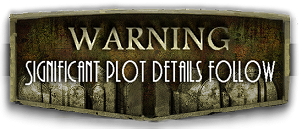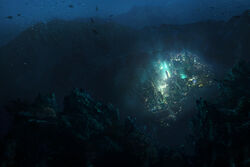
An underwater "aerial" view of Rapture.
- “...I chose the impossible. I chose... Rapture. A city where the artist would not fear the censor. Where the scientist would not be bound by petty morality. Where the great would not be constrained by the small. And with the sweat of your brow, Rapture can become your city as well.”
- ― Andrew Ryan
Rapture (also known as the North Atlantic Project and the Rapture Colony) is a massive underwater city forged by the personal dreams of Andrew Ryan to escape from the political, social and religious anxieties of a post-World War II world. It was established on November 5, 1946 and finished in late 1951. It is located at 63° 2' N, 29° 55' W, which places it at about 433 kilometers west of Iceland's capital, Reykjavik.
Background
Rapture's location
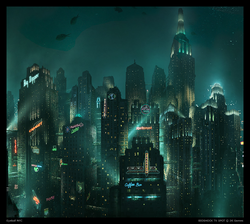
An example of Rapture's once lavish and elaborate exterior architecture.
Rapture lies at the bottom of the North Atlantic Ocean, as a gleaming metropolis of massive Art Deco-styled[1] buildings, connected by networks of reinforced glass tunnels, bathysphere transport systems, and submerged railways. It largely resembles the Manhattan borough of New York in both size as well as general appearance. The city is completely self-sustaining with its electricity, food production, water purification, and defense systems powered by the geothermal volcanic vents in Hephaestus. Fresh food and oxygen recycling are taken care of by large areas of cultivated forests and farms centralized in the Arcadia zone, as well as fish along with other sea life from Neptune's Bounty.
Transportation within Rapture is provided by Rapture Metro, a connected bathysphere system, which consists of spherical pressurized capsules, through which citizens could access most areas of the city. A terminus of the Rapture Metro system is the bathysphere dock inside the remote lighthouse in the North Atlantic, which is Rapture's only entrance from the outside world. Another mode of transportation within Rapture is the Atlantic Express, a pressurized rail system for moving a larger number of citizens (though this mode of transportation was decommissioned a long time ago). Other areas of Rapture are connected through bulkhead doors. Areas within some levels are connected by glass tunnels: smaller ones for pedestrians, larger ones for tramways of a rail system between areas. Rapture is intentionally isolated from the world and the only way to access it seems to be bathyspheres taken down from the lighthouse perched on an island above.
History
Origins
Rapture began as a dream of Andrew Ryan's from long before Rapture's construction. Andrew Ryan had thought about such a place at least a decade before a viable location was even picked. He had escaped Russia where the Communists had killed members of his family, and had worked his way to become an industrial mogul in America. He had come to view 'workers' unions, left-wing collectivists, politicians selling altruism, and organized religion as parasites ruining man's life on Earth. He considered the idea of collecting achievers and those who believed in the empowering of the individual, and closing them off to flourish in some remote location uncontaminated by the rest of society. The atomic bombings of Hiroshima and Nagasaki at the end of World War II, he predicted, would lead to the inevitable death of humanity. Ryan wasted no time in contacting like-minded associates and marshaling his resources. One of the first trusted men involved was Sullivan, who was already in Ryan's employment. With Sullivan's experience in law enforcement, he was made chief of Rapture's security. Ryan gathered many construction experts and secured the architects Simon Wales and Daniel Wales to draft the design for much of Rapture's construction. Needing workers to build Rapture, Ryan hired many of the most talented and skilled engineers, workmen and mechanics. Many, like Bill McDonagh, shared Ryan's ideals and saw Rapture as a new start where they could rise from mediocrity.
Construction
Beginning in late 1945 and throughout most of 1946, Ryan contracted a series of companies to begin construction at the selected location between Iceland and Greenland. Ryan and his associates secured the manufacturing materials in secret so as to avoid unwanted attention. These resources were then transported by ships like the Olympian thousands of miles into the North Atlantic to the project site. There, the materials would be submerged to the ocean floor via a giant State-of-the-Art submersible platform, nicknamed "The Sinker." Deep sea welders and mechanics created a foundation for the city by sinking pilings and girders far into the rock and silt. From that foundation, they built up the many buildings, slowly creating an art deco Metropolis. "The Sinker" was permanently anchored, and by November 5, 1946, Rapture had started receiving its new residents. The major construction period continued until the end of the 1940's, with smaller projects continued in and around the city until Rapture's construction was fully complete by 1951.
Rapture's Purpose
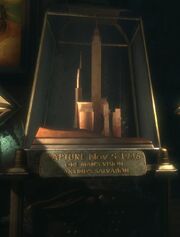
A memorial replica of Rapture's foundation on November 5th, 1946.
Andrew Ryan named his city after the goal he set in mind: To create a paradise free from all the people he saw as "parasites", a place of true rapture.
In terms of its philosophical underpinnings, Rapture can best be described as a "gulch", (a term derived from Galt's Gulch in the Ayn Rand[2] novel Atlas Shrugged).[3] A "gulch" is a localized underground economic and social community of free-minded individuals and differs from a commune in that it is uniquely freedom-focused and so upholds individual and property rights rather than operating by the rules of a collective community.
The original goal of Rapture was to create a capitalist society free of religious and government interference, where any citizen could achieve for his or her own gain, rather than for the altruistic fulfillment of the wants of others. The "world's best and brightest" would be granted freedom of will and choice in Rapture, unrestrained by government, religion and similar established institutions. Instead of abiding by the moral systems imposed by those institutions, values such as logic and scientific reason were to guide the inhabitants in their pursuit of achievement.
The would-be utopia had its flaws. In Rapture's purely capitalistic society, there were no social programs whatsoever, everything within the city was privately owned and came with a price. This included the city's food, health care, sanitation and even its oxygen supply. There were less restricted norms for businesses and labor, allowing unscrupulous business practices (such as overpriced vending service) to flourish.
This system alienated Rapture's less fortunate citizens, who began to resent Ryan as cold-hearted and elitist. Andrew Ryan's hostility and his paranoia of "parasites" led to others exploiting Rapture's freedoms and seizing power, resulting in Ryans downfall, and that of his city. His edict that the city's safety required preventing the outside world from learning of Rapture's existence, enabled a man named Frank Fontaine to build his criminal empire through smuggling. Unlike the capitalistic Ryan, the mobster could not be satisfied by mere material wealth—he wanted Rapture to be subject to his dominion. Fontaine would go on to start a civil war that sealed Rapture's doom, under the alias Atlas.
Religious Beliefs and Philosophies
"No Gods or Kings. Only Man."
Major beliefs held by citizens in Rapture:
- The Rapture Family - Everyone owes each other a sense of unity and brotherhood. This is the most recent cult to have appeared in Rapture, having been created and promoted by Sofia Lamb and Simon Wales.
- The Great Chain - Belief in self-interest and free markets that unite the people. This is more of a philosophy than a religion, as it is a belief promoted by Andrew Ryan, who is a staunch atheist.
- Christianity - Belief in the Christian God and Christ as the savior of humanity. This is an underground cult in Rapture, as it is officially banned. This ban enabled smugglers to make money off of smuggling in religious artifacts and gave fuel to demented religious fanaticism (as shown by the Waders Splicer type).
- Atheism - Absence of belief in the existence of deities. This is the official philosophical stance of Rapture, as imposed by Andrew Ryan.
- The Saturnine - A dark pagan cult found in Arcadia. According to Julie Langford, worshipers of this cult drink human blood as well as cups full of Plasmids (most likely raw ADAM). They also believe they have been "touched" by the ancient gods.
Businesses

Various advertising images from businesses in Rapture.
- Main article: Rapture Businesses
Companies that were founded in Rapture:
- Atlantic Express - Railway transportation for citizens that was decommissioned years ago.
- Circus of Values - Vending machine company that sells various items (among them, ammunition that was no doubt used during the Rapture Civil War).
- El Ammo Bandito - Vending for weapons and ammunition.
- Fontaine Futuristics - Plasmid and Tonic production facilities owned by Frank Fontaine.
- Gatherer's Garden - Vending for genetic upgrades. This business dealt with ADAM as currency, not common money.
- Jet Postal - The main system for distributing mail and parcels.
- Power to the People - Vending for weapons upgrades
- Rapture Metro - A transportation system carrying citizens to areas of the city.
- Ryan Industries - Creative and constructive facility owned by Andrew Ryan.
- Securis - Construction company for bulkhead doors and airlocks of the city.
- Sinclair Solutions - Tests and sells Plasmids and Gene Tonics for citizen customers.
Science and Technology
The Elite of Rapture Society: Brigid Tenenbaum, Sander Cohen, Gil Alexander, Andrew Ryan, Sofia Lamb, and Yi Suchong
Ryan believed that scientific achievement in the world was being restricted by "petty morality", so he ensured that the inhabitants of Rapture could explore paths of inquiry previously deemed too immoral or controversial to follow. Some scientific breakthroughs were in robotics, bringing about an advanced automated security system; others were in biology, where developments advanced in the restoration of life, both in plants (the Lazarus Vector) and humans (the Vita-Chamber). There were also some technological advancements regarding items that were created before they were commercially available on the surface, such as portable audio recording devices (approx. five years earlier), automatic doors (eight years earlier at the most) and vocal biometric security.
One of the major breakthroughs achieved in Rapture was the discovery of ADAM: unstable stem cells from a species of sea slug. This led to the creation of both Plasmids and Gene Tonics. Essentially, ADAM allowed a user to splice new genetic material into the user's DNA, enhancing health, intellect and even giving superpowers. However, ADAM was soon found to cause physical and mental damage as more of the user's native cells were replaced by unstable stem cells. The need for ADAM became an addiction, which became more pronounced by excessive splicing, mainly during and after Rapture's civil war.
Beginning of the End
The turning point.
On December 31, 1958, a massive working-class uprising, led by Atlas, occurred in upper-class locations (such as the Kashmir Restaurant). This sparked a civil war between Atlas and Andrew Ryan. This was mainly due to the addictive need for ADAM in most of the city's residents. During the 1958 New Year's Eve Riots, traditional ballistic weapons and Plasmids were used on both sides. The major conflict lasted about four months, but the violence continued to break apart the society of Rapture. In the multiplayer mode of BioShock 2, the player gets to participate in the warfare that caused the fall of Rapture. In the end, the majority of the sane population of the city was either killed off by Splicers or committed suicide. Thus, ordered society in Rapture came to an end.
Events of BioShock
Rapture at its breaking point.
By 1960, Fontaine, still posing as Atlas, was starting to feel the pressure of Ryan's legion of pheremone-controlled forces. In a last ditch effort to turn the tide in his favor, he summoned his mind-controlled assassin Jack to kill Andrew Ryan so Fontaine could take over the city for himself. After a year of ceaseless civil war, Rapture is a severely damaged underwater city teetering on the verge of collapse. Water constantly keeps leaking in every corner and the Splicers roam about the place looting or killing anyone they see as a threat. However, as bad as it is, Rapture is still holding up pretty well. Automated systems and the Big Daddies keep the city from falling apart.
Mistaking Jack for a CIA or KGB spy sent to report Rapture's location, Ryan sends waves of Splicers to deal with him, to no avail. Finally losing his patience, Ryan chooses to sabotage Arcadia's trees, depriving the city of oxygen, and trapping Jack in an area-wide lockdown. However, Jack with the help of Julie Langford manages to restore the foliage to Arcadia and continues on to Hephaestus, and Ryan's office. As Jack journeys on through Rapture unabated by the bathyspere lockdown, the Splicers, or the Security measures, Ryan slowly begins to piece together Jack's true identity. When Jack draws near to him, Ryan, in a final attempt to prevent Fontaine from gaining the city, activates the self-destruct system for all of Rapture. Although the city gets shaken, Jack manages to kill Ryan and stop the sequence, thus unwittingly turning over control of the Rapture Central Control, and in turn the whole city, to Fontaine. Fontaine reveals that his Atlas persona was a con, betrays Jack and orders his execution but Jack escapes. Eventually Jack reaches Fontaine and kills him at his towering hideout. Jack subsequetly escapes to the surface in one of the bathyspheres and either takes control of a warhead from a nuclear submarine with the aid of the Splicers or leaves Rapture with some Little Sisters to live out his life in peace.
Events of BioShock 2
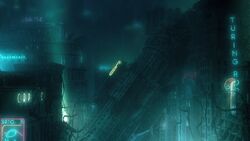
Rapture in ruin.
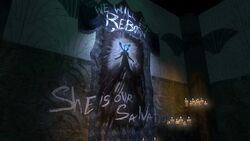
Image of salvation.
In the years following the deaths of Ryan and Fontaine, the city deteriorated into a far worse state than before. With the damage done to Hephaestus, Rapture is running on a fraction of its original power. The Big Daddies continue to do some maintenance work, but several areas are, as of now, completely flooded and, according to the Bioshock 2 trailers, some buildings have crumbled down to the ocean floor.
Despite its decaying state, there is still life left in Rapture. However, given the eight years since the first game, the Splicers have become even more desperate and deformed than before. Headed by Sofia Lamb, one of only a handful of Rapture's remaining unspliced citizens, the Rapture Family is the de-facto regime of the city and has begun to rebuild society according to Lamb's belief structures. Once the Family gained control, citizens who might have never risen to power under Ryan's Rapture received prominent positions in society. The Family embraces the idea of imbuing Sofia's daughter Eleanor with the combined genius of Rapture's citizens in order to create the ultimate altruist, a "Utopian," and ascend to the surface; their true objectives are hidden in an atmosphere of religious fervor. To achieve this, they restart the ADAM production process and kidnap a number of children from around the world to turn them into Little Sisters, since the few remaining had become old and unable to continue as ADAM processors. However, by 1968, an expired Alpha Series Big Daddy Subject Delta is revived by Eleanor and then aided by Augustus Sinclair to retrieve her from captivity and escape the city.
During Delta's journey, several parts of Rapture get destroyed as a result of his encounters with Sofia Lamb's supporters, including the Adonis Luxury Resort, the Siren Alley district, and the Persephone Detention Facility. In the end, Sinclair ends up dead but Delta, Eleanor and Sophia Lamb manage to escape in Sinclair's sumersible moments before Persephone, the Rapture Family headquarters, is destroyed by Sophia Lamb.
Current Status
With Andrew Ryan, Frank Fontaine, and the Rapture Family dead, it is unlikely that there are any sane individuals left to rule what remains of Rapture. The city itself is in no better shape, as most of it has been damaged or destroyed over the course of the games, and there is no longer anyone left to create new Big Daddies to help maintain the few livable areas. Furthermore, the Little Sisters have all been either saved or harvested, thereby removing the only viable source of ADAM in the city. With its core functions all but destroyed and its population reduced to little more than Splicers now devoid of the ADAM they so desperately crave, the fate of Rapture is ambiguous at best.
The last reference to Rapture in the series is given by Tenenbaum in the Minerva's Den DLC in which she states that she intends to stay on the surface to work for a cure for ADAM and "end the Rapture nightmare." Tenenbaum's dialogue implies that she already considers Rapture to be lost, and her new responsibility is to prevent the events that decimated Rapture from ever happening again.
Explorable Areas
The tower which houses one of the ways to Rapture.
BioShock
- Main article: BioShock Locations
During the journey through BioShock, the player will explore the following areas of Rapture:
- Welcome Center - Home to Kashmir Restaurant and first direction to all newcomers in the city.
- Medical Pavilion - Main medical, surgical, and funerary institution.
- Neptune's Bounty - The fishing district and port in Rapture, also a cover for Frank Fontaine's smuggling operation.
- Smuggler's Hideout - The center of Fontaine's criminal exploits, an abandoned tunnel network and a submarine bay.
- Arcadia - An experimental forest and recreational area in Rapture, supplying a part of the city's oxygen and other natural resources.
- Farmer's Market - Main marketplace for organic produce, home of Tasha Denu's apiary and the Worley Winery.
- Fort Frolic - Arts, entertainment and shopping district, overseen by Sander Cohen.
- Hephaestus - Geothermal power generation facility, workshops and headquarters of Ryan Industries.
- Rapture Central Control - Andrew Ryan's private quarters and office, and Rapture's genetic lock.
- Olympus Heights -Apartment complex for the high society, residents include Brigid Tenenbaum and Fontaine himself.
- Apollo Square - Transportation hub and Atlas's stronghold, also low-class apartments and Dr. Suchong's Free Clinic, turned concentration camp by Ryan.
- Point Prometheus - ADAM laboratories and genetic library, the "Birthplace" of the Big Daddies and Little Sisters main production.
- Proving Grounds - Big Daddies/Little Sisters' training area. Previously known as Rapture's Memorial Museum.
- Fontaine's Lair - Top of Point Prometheus, highest building in Rapture and ADAM mass gathering, the final battle location.
Challenge Rooms DLC
- Rapture Firing Range - A specialized facility designed for firearms practice.
- Rapture's Grand Carnival - A carnival attended by citizens for festivities.
BioShock 2
- Main article: BioShock 2 Locations
During the journey through BioShock 2, the player will explore the following areas of Rapture:
Rapture through the eyes of Subject Delta.
- Adonis Luxury Resort - A Plasmid/Gene Tonic therapy center for the upper-class citizens of Rapture themed after Greek mythology.
- Atlantic Express Depot - The main administration and facility for maintenance and development of Atlantic Express trains.
- Ryan Amusements - An amusement park where the children of Rapture were taught about the "evils" of the surface world and the story of Rapture's construction.
- Pauper's Drop - Home of the working class. It was constructed by the workers themselves in secret. Previously known as the Maintenance Junction 17.
- Siren Alley - Rapture's red-light district. Previously known as the mason's quarter.
- Dionysus Park - A free park that Lamb made as a counterpart to Arcadia. She also used it as a way to spread her ideals through art and nature.
- Fontaine Futuristics - The headquarters of Frank Fontaine's Plasmid business, seized by Ryan.
- Persephone Penal Colony - A hidden penal colony used to hold Rapture's political dissidents, now Sofia Lamb's base of operations.
- Outer Persephone - Lamb's private office and base of operation.
- Inner Persephone - The holding cells, the infirmary and the therapy facilities of the prison.
Minerva's Den DLC
- Minerva's Den - The hub for Rapture Central Computing and advanced robotics manufacturing.
- Operations - Center for operations and maintenance of Rapture's central computing mainframe.
- The Thinker - Home of The Thinker (Computer), the Artificial Intelligence behind Rapture's computer mainframe.
Mentioned Areas
- Athena's Glory - Apartment complex located next to Olympus Heights.
- Cameron Suites - Mentioned on advertisements for Pharaoh's Fortune Casino.
- Water Treatment Station - Mentioned on newspapers scattered on the floor. It was shut down after some water contamination by a pathological bacteria.
BioShock Infinite
- Nearing the end of the game, the Welcome Center is explorable for a small section when Elizabeth teleports herself, Booker DeWitt and Songbird there (destroying the latter in the process). A Little Sister can be seen mourning a Bouncer Big Daddy in the background. As Elizabeth and Booker travel through time and space, it is revealed that the city of Rapture is one of the "constants" in every timeline, bound to appear in one form or another in the continuum. In BioShock Infinite's set of timelines it takes the form of Columbia, an early 20th century city floating in the sky.
Video

A look at Rapture
Behind the Scenes
- The names of a majority of the locations in Rapture are inspired by gods and locations from ancient Greek, Roman and Biblical culture.
- Although contact with the surface was forbidden, the surface bathysphere was not disabled (although still under genetic lock). Jack, Orrin Oscar Lutwidge, and Mark Meltzer were able to enter Rapture via this method.
- Much of the external architecture of Rapture was inspired by the art deco architecture of New York City, particularly the Rockefeller Center[4][5] and the work of Hugh Ferriss,[6] who created perspective drawing of New York buildings in the early 1900s.[7]
- Rapture is similar to the mythical lost city of Atlantis[8] in many respects. Both of them are underwater cities isolated from the rest of the known world, and their inhabitants were able to master technology far more advanced that what had been discovered on the surface. Both became plagued with corruption, which led to their ruin. Moreover, one of the chapters in Atlas Shrugged is called Atlantis, and the mythical city is likened to Galt's Gulch by the characters.
- The name Rapture is inspired by the Biblical concept, meaning an event in which the faithful will be taken to Heaven.[9] In this case, the smartest and most artistic flocked to Rapture.[10]
- As seen in Deco Devolution: The Art of BioShock 2, "Rapture is anchored- (while drilling piers, a huge cavern is discovered directly below)."
- If the co-ordinates 63° 2' N, 29° 55' W are input into Google Maps, it would return a photo of the city of Rapture from BioShock which reads "The City of Rapture."
- In BioShock Infinite, the Welcome Center that Booker and Elizabeth find themselves in is not identical to the Welcome Center at the start of BioShock. The Gatherer's Garden machine in the Bathysphere Station is completely empty, suggesting that Booker and Elizabeth arrive at some point after Jack's first arrival in BioShock.
- Further evidence of this is that the doorway into the Welcome Center that Jack must clear with the wrench is now clear, but still shows signs of debris around it, suggesting that Jack had already been through here and cleared the passageway.
- In an ironic moment, Booker, upon realizing Rapture's location, comments on how a city at the bottom of the ocean is "ridiculous".
References
- ↑ Art Deco on Wikipedia
- ↑ Ayn Rand on Wikipedia
- ↑ Atlas Shrugged on Wikipedia
- ↑ Rockefeller Center on Wikipedia
- ↑ "Unreal Engine 3 Powers Critical and Commercial Success BioShock" article by John Gaudiosi at UnrealEngine.com
- ↑ Hugh Ferriss on Wikipedia
- ↑ BioShock 2 Q & A: "It's More Personal This Time", IGN interview with Hogarth de la Plante by Michael Thomsen, IGN.com
- ↑ Atlantis on Wikipedia
- ↑ Rapture on Wikipedia
- ↑ "Episode Three: What is Rapture?" BioShock Podcast on the Cult of Rapture

